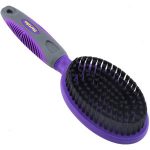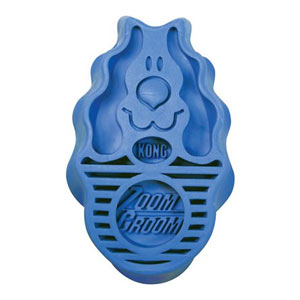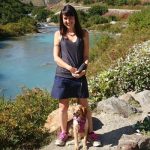Labradors have a short coat that’s relatively easy to maintain, but they can be prolific shedders. This article will explain a Lab’s coat and the importance of grooming. I’ve also recommended four of the best brushes for Labrador Retrievers.
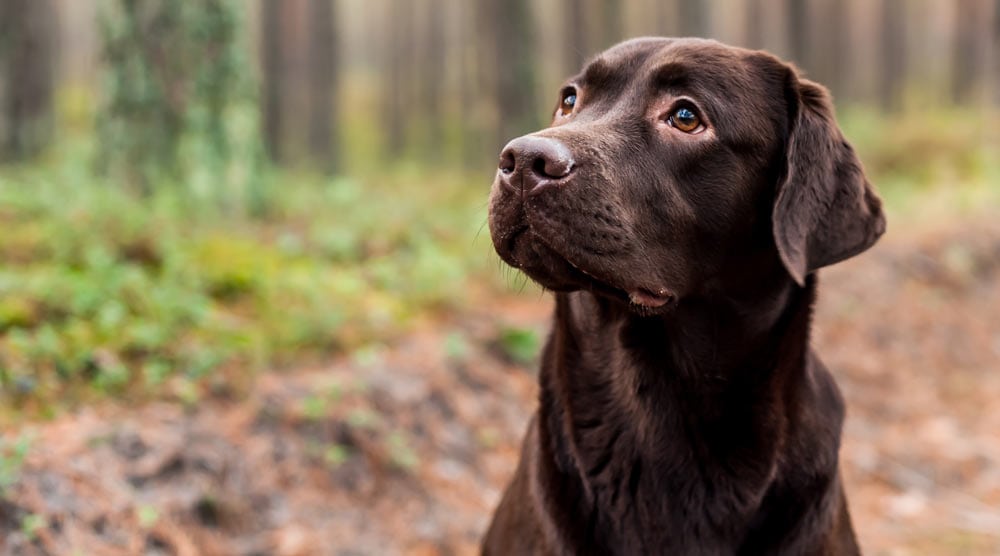
Contents
Removing dead hair isn’t the only reason to brush your Lab though. Brushing also promotes healthy skin and distributes natural oils. Grooming can also strengthen the bond between you and your dog – as long as sessions are positive!
To ensure your Lab enjoys your grooming sessions, it’s important to use the right types of brush. The best brushes for Labrador’s can penetrate the thick coat and remove dead hairs, without causing discomfort.
In this guide, I’ll help you understand your Lab’s coat and the type of brushes that work best. I’ve also suggested four of the best brushes for this breed to help you make an informed choice.
Our #1 Pick: Hertzko Bristle Brush
A high-quality bristle brush that’s great for Labs
My top pick for a dog brush for Labs is the excellent Hertzko Bristle Brush. It’s great for removing dead hair and distributing natural oils. The non-slip handle also makes it more comfortable to hold when grooming.
What Type of Coat do Labrador Retrievers Have?
The Labrador Retriever was developed in England during the 19th century, after being imported from Newfoundland in Canada.
Part of the “sporting group,” Labs were bred to retrieve game, which requires intelligence, a strong work ethic, and relaxed temperaments. They often also referred to as flushing dogs, as part of their job was to scare birds from undergrowth into flight.
The Labrador’s history has had a major impact on the breed’s coat. Their job involved working in harsh weather conditions and frequently required the Labs to retrieve from water.
As you can imagine, diving into cold English rivers and streams requires a water-resistant and insulating coat. The Labrador’s double coat is also relatively oily and quick-drying.
It’s important that grooming maintains the coat’s health, but doesn’t disrupt these beneficial properties.
What is a Double Coat?
There are two layers to a Lab’s coat: the outer coat and undercoat.
The outer guard hairs are strong and coarse. They protect against injury and dirt, and are effective at repelling water.
The soft, dense undercoat provides insulation for your Lab in the winter. It also traps air, which keeps the dog cooler in the summer.
While all Labradors have double coats, the density can vary depending on the variation. “Show” types tend to have a thicker coat, while the “field” or “working” type has a thinner and sleeker coat. Labradors with “show” coats also tend to shed more.
Do Labs Need to be Brushed?
Although Labradors are unlikely to develop knots or matting, brushing is still essential.
Labs are high-shedding year-round, and during their bi-annual blow out you’ll likely be shocked by the amount of hair they lose. It’s even been suggested that the average Lab sheds around 70 pounds of pet hair per year! Brushing can remove dead hairs, so they are less likely to end up on your sofa or carpets.
A regular grooming routine also has a host of other benefits, including:
- Distributes the coat’s natural oils and promotes healthier skin
- Increases the coat’s shine
- Promotes new hair growth
- Removes dirt and debris (water-loving labs can get mucky)
- Improve the coat’s temperature regulating properties
- Increases the chance of you spotting lumps or abnormalities on the skin that are hidden under the coat
- Can be relaxing for your dog when performed gently (and can also strengthen your bond)
While the frequency of grooming depends on the individual Labrador, a brush twice a week should be sufficient. When your dog’s coat is going through the seasonal moult, you may need to brush them daily to keep the dead hairs at bay.

Why You Shouldn’t Shave a Lab
The insulating qualities of this breed’s coat is one of the reasons you should avoid shaving a Labrador. Shaving can alter the texture of the coat, in some cases permanently, and make it harder for your dog to maintain a comfortable temperature. It may also make the coat less water resistant.
There are some situations where shaving is unavoidable though. If your Lab needs surgery or is dealing with a skin condition, your vet may recommend shaving part or all of the coat.
Which Are the Best Types of Dog Brush for Labradors?
There are many types of dog brush, ranging from stainless steel combs to rubber curry brushes, so it can be a challenge to know which to choose for your Labrador. Here’s an overview of the various types and why they are suitable for Labradors.
Bristle Brush
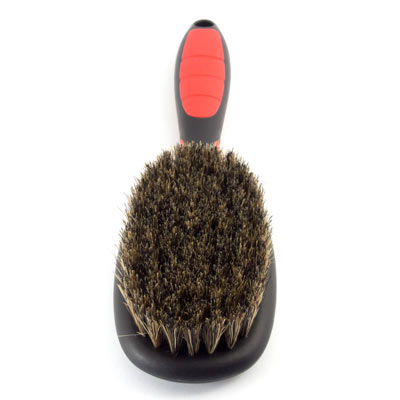
Bristle brushes are probably the best option for Labradors. They are gentler than alternative grooming tools, such as slicker brushes, yet still do a great job at maintaining the coat of smooth-coated dogs.
The densely packed bristles are perfect for brushing out dried-in dirt from the topcoat and promoting a healthy shine. Considering what mud magnets Labs can be, this could prove invaluable! They are also a great choice for puppies, who have more sensitive skin.
A bristle brush can also remove large amounts of loose hair from short coats, while stimulating the skin and spreading natural oils.
Bristle brushes often come in a 2-in-1 format with a pin brush. Pin brushes aren’t as useful for Labradors as they are for long-haired dogs, but may still help to lift a small number of dead hairs from the coat.
Deshedding Grooming Tool
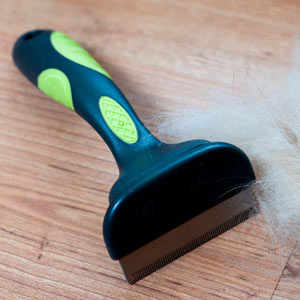
If you want to minimize the amount of loose hair around the home, consider buying a deshedding tool for your Labrador. Deshedding tools are brilliant for removing dead hair, especially during your Lab’s coat blow out – but they must be used with caution.
These tools have rake-like teeth that penetrate the coat and grab hold of dead hair. It’s surprising how much they lift out in one session!
Because of how effective they are, some owners can get carried away. It’s important not to use this tool more than once or twice a week, even during moulting season. Using them too much can start to damage hairs.
When brushing your Lab with a deshedding tool, be aware of how much pressure you’re using. Short, gentle strokes are all that’s required. If you apply too much pressure, it can cause discomfort or skin irritation for your dog, and you risk cutting healthy hairs too.
Note: Deshedding tools aren’t suitable for puppies or dogs with sensitive skin.
Rubber Curry Brush
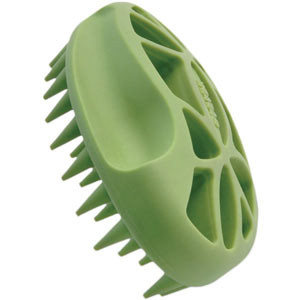
Although a rubber curry brush isn’t an essential grooming tool for a Labrador, these brushes have several benefits you don’t get from other types of brush.
Featuring moulded rubber teeth, curry brushes are a gentle option for removing dead hair. They aren’t as effective at brushing out hair as a slicker or deshedding tool, but are a better option for nervous dogs or those with sensitive skin.
Aside from removing dead hair, a curry brush can spread natural oils through the coat. Some dogs also enjoy the massaging effect, which can make grooming sessions more pleasant.
Rubber curry brushes are particularly useful when bathing your Lab, as the rubber nubs help to generate a good shampoo lather. They can also remove ingrained dirt and gather dead hair.
Tip: Want to learn more about dog brushes? Take a look at our full guide to brushes.
Slicker Brush
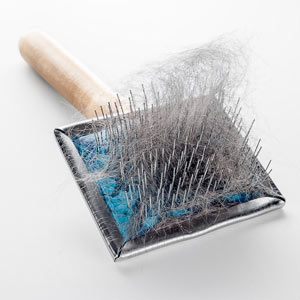
Slicker brushes are typically used to prevent tangles in medium, long or curly hair breeds. They are often too harsh for grooming the main coat of short-haired breeds, such as Labradors, but can be useful if your Lab has longer areas of hair (such as around the rump).
The angled and flexible pins on these brushes are effective at penetrating a coat to remove dead hair. They also stimulate the skin and ensure that natural oils in the coat are distributed evenly.
Because the pins are made from metal, they could cause discomfort for your Lab if you apply too much pressure, or focus on one area for too long.
Make sure you use short, gentle strokes and that you don’t use the slicker on areas with short hair.
Which is The Best Dog Brush for Labs?
Listed below are my top four recommended brushes for Labradors. The type you should choose depends on your individual dog’s outdoor activities, their tolerance for being groomed, and their shedding levels.
This Hertzko Bristle Brush is my top pick for a Labrador brush. It’s great for removing loose hairs and brilliant for Labradors that are mud magnets!
Bristle brushes are perfect for brushing out loose hairs from short-haired breeds. They can’t penetrate the coat like a slicker, but this usually isn’t a problem for breeds with short, smooth coats. The densely packed bristles of the Hertzko can also remove dried-in dirt and debris from the topcoat and promote a healthy shine.
The Hertzko Bristle Brush is a decent size and has a non-slip rubber grip handle. Given that it can take a while to groom the full coat of a large breed like a Labrador, this is a great benefit.
One drawback is that hairs caught in the bristles can be difficult to remove. This is a common issue with all bristle brushes though, so it’s not a complaint about the Hertzko specifically.
The Hertzko is well-made and provides excellent value for money. If you’re not sure which brush to buy, this is probably the best brush for Labs.
Tip: If your dog is nervous about being groomed, the Hertzko Bristle Brush might be a good starting point. Just be sure to combine it up with lots of yummy treats and positive associations.
VIEW PRICEIf you want to remove as much dead hair from your Lab’s coat as possible, then the Furminator deShedding Tool is worth considering.
You’re unlikely to find any brush that can remove more dead hair – at least without spending hours on each grooming session. It’s particularly helpful when your dog is experiencing their seasonal coat blow.
Outside of the moulting season, using it around once a week should be enough. When your Lab is having their coat blow out, you may find it helpful to use it 1-2 times a week.
The FURminator should be used in moderation though. If it’s used too frequently or with too much pressure, you risk irritating the skin or damaging healthy hair. The serrated teeth are also too harsh for puppies with their delicate hair and sensitive skin.
VIEW PRICEIf you want a gentle brush that can still remove loose hairs, then the Kong ZoomGroom is worth trying out. The flexible rubber creates a massaging sensation, which is more comfortable for most dogs.
It’s not as effective as a slicker or deshedding tool, but the rubber nubs still gather dead hairs as you work the coat. The hairs are easy to remove too – just rinse the brush under the tap.
Using the ZoomGroom in circular motions also stimulates the skin, distributes oils and can be relaxing for your Lab.
The ZoomGroom is a handy tool for using when you’re bathing your Labrador. It can help to generate a lather and ensures the shampoo penetrates deep into the coat, helping to lift out deeply ingrained dirt.
VIEW PRICEIf your Labrador has patches of longer hair, the Hertzko Self Cleaning Slicker could be a useful brush to add to your collection. This well-made brush is great for lifting out loose hair and leaves the topcoat with a healthy shine.
What makes the Hertzko stand out from other slicker brushes though?
Firstly, the durable brush pins have a degree of flexibility, so they are less likely to cause discomfort. It’s still important not to apply too much pressure, but the Hertzko provides a good balance between comfort and effectiveness.
The Hertzko slicker also has a retractable bristle function, making it much easier to remove gathered hairs. You just push a button to draw the pins into the body, so you don’t need to pluck them out by hand.
Additionally, the Hertzko grooming brush has a non-slip and ergonomic handle. This ensures you’ll have a firm and comfortable grip – even if your hands get a little sweaty.
A downside is that the rubber is less durable than a hardwood handle. It should still last a long time, however, and the brush provides great value.
Tip: If you have a field Labrador, with a less dense coat, care should be taken not to apply too much pressure when grooming with a slicker brush. The pins could scratch or irritate the skin. For puppies, it may be better to opt for something a little gentler too.
VIEW PRICEFrequently Asked Questions
How Often Should You Brush a Labrador?
Brushing frequency depends on the thickness of your Labrador’s coat, whether they often get muddy, and if their coat is having a blow out.
For most of the year, brushing a couple of times a week should be enough to keep the coat and skin in good condition.
When a Lab is having their coat blow, daily brushing will help keep loose hairs at bay and promote healthy skin and hair regrowth. Remember, however, that deshedding tools (such as the FURminator) aren’t appropriate for daily use.
How Often Should You Bathe a Labrador?
Labradors have a naturally oily and water-resistant coat, but too much bathing can strip these oils. This increases the chance of irritated or dry skin.
Ideally, you don’t want to bathe your Labrador more than once every 3-4 weeks. If they aren’t a mud magnet, they may not even need bathing as frequently as that.
For Labs that are drawn to muddy puddles, or who have particularly oily skin, you may find they start to pong after a while. Giving them a bath using an odor-control shampoo may be beneficial – but you should still avoid washing them too often.
Labradors are a breed that can be more genetically predisposed to skin allergies and dandruff. If your Lab is in this category, you may find it beneficial to use a dandruff shampoo to help manage this.
What Coat Colors do Labs Come In?
The three formally recognized colors that Labs come in are black, yellow and chocolate. Black is the most common coloring, but there are plenty of each colour.
You may sometimes hear people refer to their Lab as being ‘Fox Red’. This is actually just a darker shade of the accepted yellow coloring.
The color of your Labrador’s coat doesn’t impact the type of brush you should use.
Summary
Although Labradors don’t suffer as much with tangles or mats, they still need regular brushing to remove dead hair.
My favorite brush for Labrador Retrievers is the Hertzko Bristle Brush. It’s suitable for daily use, has a durable design, and lifts out lots of dead hair.
If you’re looking for a deshedding tool, then the FURminator is the obvious choice. A rubber curry brush can also be great for brushing during bath time.
I hope this article has helped you choose a brush for your Labrador Retriever. If you have feedback or would like to ask further questions, please get in touch using the comments box below.
